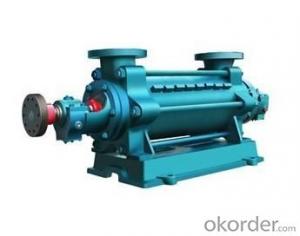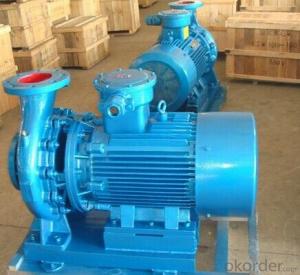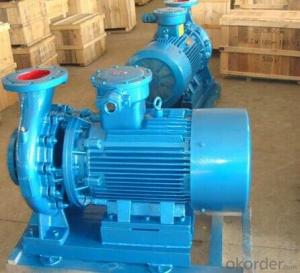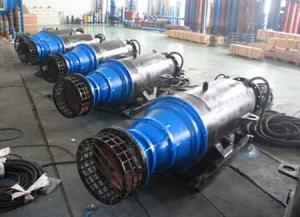ISW Horizontal Centrifugal Pump
- Loading Port:
- Shanghai
- Payment Terms:
- TT OR LC
- Min Order Qty:
- -
- Supply Capability:
- 500 set/month
OKorder Service Pledge
Quality Product, Order Online Tracking, Timely Delivery
OKorder Financial Service
Credit Rating, Credit Services, Credit Purchasing
You Might Also Like
Product Introduction:
ISW series single-stage single-suction vertical pipeline centrifugal pump is the second generation of high efficiency energy-saving product designed by our company based on many years of production experience as per the performance parameters stated in the internatonal standard ISO2858 and the national standard JB/T6878.2-93.It is an ideal substitute for normal pumps like SG and D multi-stage centifugal pumps. The series has a flow range of 1.5-1600m3/h and a lift head range of 5-125m, which includes many specifications like basic, diversion and cutting types.Accordingly, this series can be widely applied to replaced the normal centrifugal pump completely to be used in all cases.
Range of Application:
Industrial and urban water supply , pressurization of water supply network, daily and fire water supply for constructions, central air conditioning system,cyclic pressurization for other cold and hot clean medium.
Type Designation:
ISW ISWR ISWH ISWY ISWD 100-160 (I) A(B)
ISW – Single-stage Single-suction Horizontal Centrifugal Pump
100 – Diameter of pump inlet and outlet (mm)
160 – Nominal diameter of impeller (mm)
I – Flow classification
A – Primary cutting of impeller
B – Secondary cutting of impeller
Technology Parameters:
Flow:4-1200m3/h;
Head:5-150m;
Power:0.55-250kw;
Rotary speed:980-2900r/min;
Calibre:25-500mm;
Temperature range:-20℃-+120℃
- Q: can't get the pulleys to line up I know I have a mid 70's 400 and the water pump is later than 1969 but I can't find a pulley that works every one is about a half inch off I bought a aftermarket set of underdrive pulley's from march performance and still the same problem the water pump is a half inch off there was no long or short water pump right they are all the same lenght right??? The only difference I know of is that pre 1968 the pumps have a 8 bolt design and after they have a 11 bolt design is that right???
- did you happen to loose the aluminum spacer between the water pump output shaft, and the fan pulley?
- Q: just changed the water pump on my lower unit installed the lower unit and started motor now there is no water coming out of the upper flow tube is it becouse the engine is not warmed up yet or is something not lined up ...........
- It shouldn't take long for the water to come out. Make sure the site tube isn't plugged up. If not, check your installation out.
- Q: water flow at faucet only when pump is running, but flow is slow
- Most RV water pumps have a pressure switch. They shut off a few seconds after you initially turn them on because they have pressurized the line. Once you open a water valve (faucet/toilet) the pump will start running again. Low flow could be caused by the size of the pump, size of plumbing, or line blockage.
- Q: 1.5KW water pump caliber is 40, what is the flow rate?
- Because you provide a wide range of data, there are several models and lift and flow, if you are interested, please leave a message for me to communicate
- Q: 93 Cutless Sierra FWD
- It's a major job involving the belt tensioner and quite a few other hard to get at parts as the water pump is buried against the side of the engine compartment. But if you want to try it borrow from the library or buy a Chilton's or any popular service manual and follow the directions (STEP BY STEP),good luck
- Q: does aquarium pump go in water?
- Yes! it would not work otherwise.
- Q: Why is water pumping cool water is normal, but when pumping hot water pressure and flow are very small?
- You look at what you pump that is, there are manuals to see how much the media can not exceed the degree,
- Q: This is what it is doing- the actual pump that is in its own little shed CLICKS all of the time water is being ran, even a small amount of water. The water pressure goes to a slow trickle and eventually stops completely. After about 20-30 minutes I go back and check the spickets and the water is fine, but quickly repeats this same cycle. We just installed this pump about 3 weeks ago. It was doing fine until last week. Does it need to be primed or pressure switch settings increased or decreased? Or am I talking totally out of my head?!
- Might be air in the water lines. Be careful and don't allow the pump to run very long when it isn't pumping any water or you will be buying another pump. It sounds like it is loosing it's prime as it builds up enough to send water to the faucets and then looses it's prime and then has to wait until it builds up enough to start over again. You may need to call someone out and have them run down the problem before you burn up your new pump.
- Q: Every time i turn off the engine i hear like liquid noises behind the dash board in the drivers side. My fan isnt working properly but i just took a trip...4 hours away.. on the highway the temperature would be fine but on regular streets my temperature goes high pretty fast..i have been putting anti freeze pretty often lately because it goes low but there is no signs of a leak anywhere. Could it just be that my fan isnt working properly or is it because the water pump is going bad? or both? I have a 93 Toyota celica
- Not it's because you have a cracked cylinder head. Does the exhaust spew out a lot of white smoke? Edit: Having a blown head gasket does not explain the missing coolant. If you had a misfire or the engine was struggling a little then yes the head gasket would explain that. If you've never seen white smoke from the exhaust or under the hood, then I would say it is because the fan is not working properly. The gurgling that you hear is the boiling water going from the radiator to the reservoir tank. It is probably overfilling the reservoir tank and evaporating as well.
- Q: my 98 expedition keeps over heating, i replaced the water pump, thermostat,coolant. it will be fine one minute then it overheats. weather im on the road or sitting at a light. i also replaced the fan clutch. thanks!
- If you have the 5.4L motor it will have a plastic intake manifold. Look at the front. There is an aluminum crossover pipe attached to the front on the top. Those are famous for leaking aroung where the intake meets the head and where the aluminum and plastic meet. You may need a flashlight and a small inspection mirror to check all the way around. Also if the valley or apace between the heads has coolant sitting in it that's a good bet you have a leaking crossover or a head temp sensor leaking. The head temp sensors are located at the back of the heads. The other common spot for coolant to leak is the heater hoses be sure to check at all the fittings and make sure they haven't come apart up by the firewall. One last thing to check is the belt around the water pump pulley. It is easy to put it on so the water pump spins the wrong way. Common mistake. Lastly if the manifold IS leaking do NOT attempt to do this if you do not have a top notch torque wrench!!! You can very easily strip the bolts or holes that are in the heads. If you are not sure take it to a good technician. Dorman makes a good replacement manifold for about 200-300 bucks. The gaskets are made onto it. I have had no issues with that one leaking. Also do not try to relpace just the crossover... I know that it has bolts and they sell gaskets but it will leak. If the manifold needs to come off it is also a great time to change the plugs. They will be super easy at that point, be sure to use new Injector o-rings too. Hope that helps. Jim
Send your message to us
ISW Horizontal Centrifugal Pump
- Loading Port:
- Shanghai
- Payment Terms:
- TT OR LC
- Min Order Qty:
- -
- Supply Capability:
- 500 set/month
OKorder Service Pledge
Quality Product, Order Online Tracking, Timely Delivery
OKorder Financial Service
Credit Rating, Credit Services, Credit Purchasing
Similar products
Hot products
Hot Searches
Related keywords


























